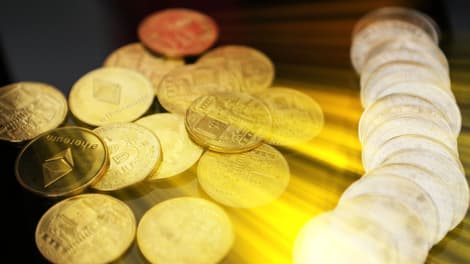What Is Qtum
Qtum is a cryptocurrency software project built to combine different parts of Bitcoin as well as Ethereum in order to entice application developers. Bitcoin and Ethereum are extremely specific to design for, and when we blend these aspects of these two networks, such as is the case with Qtum, we have an alternative that can compete on the level of Ethereum while also maintaining its compatibility with Bitcoin.
QTUM is the native cryptocurrency that is used to pay fees to help in the operation of the network, where the distribution of the newly minted QTUM is based on the ownership of the asset. Furthermore, the QTUM coins also give users the right to vote on the on-chain governance system, which incentivizes the purchasing and holding of QTUM tokens as that way the users can influence the decision-making process in terms of the software development direction of the project.
Qtum is also a general-purpose blockchain that addresses issues the founders found problematic. This includes the interoperability, governance, rigidity, and cost of proof-of-work blockchains, as well as the level of difficulty that is present in order to connect smart contracts on them.
The account obstruction layer integrates the UTXO or Unspent Transaction Output account layer from Bitcoin with the smart contract Layer and allows users to build applications and even host them on many virtual machines. The decentralized governance protocol even allows smart contracts to change the core parameters within the network, such as the block size and gas fees, and all of this is made possible without a need to hard fork the blockchain.
The main reason why Qtum chose MPoS as a consensus mechanism is due to the fact that the protocol can incentivize the users to keep their coins locked and facilitate as well as secure the block validation, a process called staking. All of this contributes to the QTUM price. Furthermore, the initial supply of QTUM coins was capped at 100 million, all of which were minted even before the project went online. 51 million out of them were sold through an ICO process in March of 2017. Now, the coin supply is not fixed, and new tokens are mined with block rewards halving every four years.
Qtum Founders
Discussing the founders of Qtum (QTUM), we have Patrick Dai which is the founder and currently fills the role as the chairman of what is known as the Qtum Foundation.
Regarding his experience and history, he studied computing science and started a career as a project manager at Alibaba. He also worked on different blockchain projects such as Bitse Group, VeChain, Factom, and Meilink before he started Qtum in 2016.
Furthermore, we have two other co-founders, including Neil Mahi and Jordan Earls.
Regarding its history, in 2017, the Qtum Foundation had an initial coin offering (ICO) that managed to help them raise $15 million through selling 51% of the QTUM cryptocurrency that was in existence before the launch.
How Does QTUM Work
Regarding the usage of the QTUM token itself, the QTUM cryptocurrency has a huge role when it comes to the maintenance as well as the operation of the Qtum network. By this, the holders of QTUm have the ability to pay for fees, hold it, spend it, stake it or send it.
Through owning QTUM at the right QTUM price, you even have the ability to vote on network upgrades, where each of the votes is proportional to the amount of QTUM cryptocurrency you will end up staking.
Now, in terms of Qtum's technology, the developers essentially modified some of the code Bitcoin had in order to allow the software users to write smart contract applications on it. The base layer copies the transaction model known as UTXO, and an additional layer was added on top to operate in a similar way as Ethereum's virtual machine. This is the main way through which smart contracts and decentralized programs are executed. Qtum even went the extra distance and ended up building their own virtual machine, which allows developers to write as well as execute programs across the distributed network of computers.
This is where we need to discuss the account abstraction layer, or ALL for short, which is the signature technology used in the Qtum blockchain with the intention of communicating between two layers.
In this case, Bitcoin's code was modified with a set of new commands, where the AAL creates, executes, and handles the contracts that operate. It also updates the blockchain ledger after a smart contract transaction has been fully processed.
Now, there has to be a consensus mechanism to keep all of this synched, and as such, Qtum uses a variation of the popular proof-of-stake (PoS) consensus mechanism known as mutualized proof-of-stake or MPoS for short. Here's how it works: for nodes to be able to validate as well as process a transaction, they have to stake QTUM in a wallet. Through validating, processing, and even recording the transactions, the nodes can receive a reward in the form of a newly minted QTUM. Furthermore, they also get transaction fees which are included in the block. Every single new block reward is divided equally between the block-producing nodes as well as the nine previous ones.
This is all reflected in the QTUM price, and QTUM data, which makes QTUM alternatives as Ethereum's gas congestion continues, and the Ethereum Virtual Machine is flooded, which makes supporting smart contracts more difficult. This can be thought of as a hybrid blockchain that uses Bitcoin's UTXO transaction model and aids in helping Ethereum fees and centralized exchanges through its transfer protocol on decentralized applications. This makes QTUM an appealing blockchain for businesses that want to launch new kinds of applications on a blockchain, as QTUM can integrate the software it has into open developer offerings.
Where Can You Buy QTUM
Qtum has an available supply of 103,601,125 and a total supply of 107,822,406 coins.
If you want to buy, sell or trade Qtum (QTUM), you can do so on exchanges such as Binance Futures, Exx, CoinBene, OKEX, Upbit, Binance, and ZBcom.











